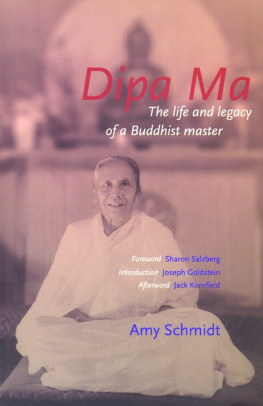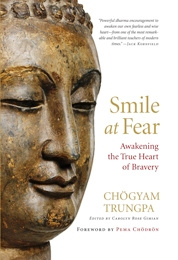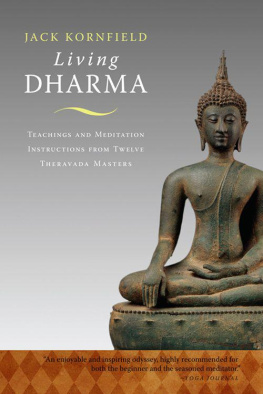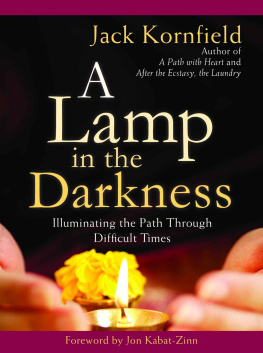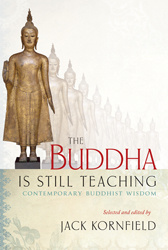
Table of Contents
by Sharon Salzberg
by Joseph Goldstein
by Jack Kornfield
Illustrations
Dipa Ma
The Life and Legacy
of a Buddhist Master
Amy Schmidt

Published in the UK and Europe by
Windhorse Publications Ltd
169 Mill Road
Cambridge CB1 3AN
Amy Schmidt 2005
Electronic edition 2012
This edition published by arrangement with United Tribes Media Inc.
The right of Amy Schmidt to be identified as the author of this work has been asserted by her in accordance with the Copyright, Designs and Patents Act 1988
Cover design Satyadarshin
A catalogue record for this book is available from the British Library
Paperback ISBN 10: 1 899579 73 7
ISBN 13: 978 1 899579 73 0
epub ISBN: 978-1-907314-80-3
kindle ISBN: 978-1-907314-79-7
Parts of this book were first published as Knee Deep in Grace
The lines quotes on page 30 are from the Dhammapada , chapter
16, verse 212 (section 4, pages 5960), translated by the
Venerable Balangoda Ananda Maitreya and revised by Rose
Kramer (Omni Foundation 1988).
Wendy Palmers story This Life is in Trouble on pages 99100 is
adapted from The Practice of Freedom by Wendy Palmer.
Reprinted by permission of Rodmell Press.
Published in the United States of America by Bluebridge, an imprint of
United Tribes Media Inc.
A Windhorse Publications ebook
Windhorse Publications would be pleased to hear about your reading experiences with this ebook at info@windhorsepublications.com
References to Internet web sites (URLs) were accurate at the time of writing. Neither the author nor Windhorse Publications is responsible for URLs that may have expired or changed since the manuscript was prepared.
Dedicated to
Dipa Ma
Foreword
I REMEMBER DIPA MA not only as my teacher but as a woman, a mother, and a grandmother. I remember her, sitting on the floor of the house in Barre where she and her family were staying when they visited the Insight Meditation Society. She would be playing games with her young grandson Rishi, laughing, and then she would get up to instruct someone in meditation. Afterwards perhaps she might go wash her clothes by hand and hang them out to dry. She might do walking meditation, then return to the house to sit. Rishi would be running around the room, while her daughter Dipa would be cooking. And Dipa Ma would be meditating right there in the midst of all that activity. Whenever anyone sat down in front of her, she would open her eyes and shower the person with blessings. This was how Dipa Ma taught, with warmth, simplicity, and goodheartedness.
Many times I hear her voice whispering to me, challenging me to extend myself to find what I am actually capable of, especially in terms of love and compassion. She was an incredible model of kindness, the type that is born of great suffering, and a consequent, constant remembrance of what is really important. When I find myself hesitating, frightened of opening up to somebody, I see an image of her as she comes out of meditation in a chaotic room, and blesses someone. I hear her voice encouraging me. Then, filled with her blessing, I reach beyond my fears to find within me the lovingkindness she embodied so strongly.
Sharon Salzberg
Introduction
THERE MAY BE a few times in our lives when we meet a person who is so unusual that she or he transforms the way we live just by being who they are. Dipa Ma was such a person. I had first heard about her from my teacher Anagarika Munindra when I went to Bodh Gaya, India, in 1967 to practice meditation. He had trained Dipa Ma in Burma, where he had been practicing and teaching for the previous nine years. He spoke of her often as being an extraordinary yogi (meditator) with unusual attainmentsmany of which you will read about in this book. What he did not say in words, but which was apparent from the first time of my meeting her, was the special quality of her being that touched everyone who met her. It was a quality of the quietest peace fully suffused with love. This stillness and love were different from anything I had encountered before. They were not an ego persona, and they didnt want or need anything in return. Simply, in the absence of self, love and peace were what remained.
Dipa Ma brought forth our best efforts, not by rules but by inspiration. She showed what was possible by being what was possibleand it raised the bar of our own aspirations. She had unwavering confidence in each of our abilities to walk the path of dharma. That confidence was conveyed with a total acceptance of where we were, along with a relentless encouragement to deepen our understanding through continued practice.
Although Dipa Ma made only two trips to the West, her impact on Buddhism in America has been profound. She was the first truly accomplished woman meditation master in the Theravada tradition to teach in this country. Although she had a deep devotion to the tradition, she also had a fierce understanding that the spiritual accomplishments of women (and householders, at that) could be in every way equal toand often deeper thanthose of the predominantly male religious hierarchy. In this way, too, Dipa Ma became a powerful role model here for women and men alike. The effect she had on so many practitioners is still rippling throughout the dharma community.
I am delighted and grateful that Amy Schmidt has brought forth this wonderful book. It is a chance for many of us to recall stories and encounters with Dipa Ma and an opportunity for others to meet Dipa Ma for the first time.
Joseph Goldstein
Preface:
Discovering Dipa Ma
LONG BEFORE I ever heard her name, Dipa Ma was calling to me.
When I was nineteen, someone handed me a copy of Herman Hesses Siddhartha . I read it four times and underlined almost every sentence. The book offered me hope. It said and I desperately wanted it to be truethat there was a way out of suffering, that it was possible to be free in this human life. I began to practice Transcendental Meditation, but I didnt find my way to the dharma, or Buddhist teaching, until five years later. At a back-alley coffeehouse in Seattle called the Allegro, I saw a flyer advertising a dharma group posted on their bulletin board. I was curious, so I dropped in. Someone instructed me in sitting meditation.
Immediately I sensed that Id found something deep and meaningful in this practice, something I knew I had to stay with. A teacher from Thailand visited the group and spoke about enlightenment. He said it was the goal of meditation, and that it was indescribable, beyond body and mind, beyond all suffering. What intrigued me more than what he said, however, was what remained unspoken: the mystical silence surrounding his words, the deep calm in his eyes. That night, walking home in the rain, I was brought to a halt by a strong sensation. With the rain pouring down my face in the darkness, I vowed to dedicate the rest of my life to finding enlightenment. No matter how long it tookno matter what it tookI knew I would not stop until I had experienced that peace for myself.
From time to time, Buddhist teachers came to visit our group: a man who had been ordained in Burma (now Myanmar), several monks from the Thai tradition. Invariably these were male teachers who talked about their male teachers. Where are the women in this tradition? I wondered, Where are my mentors?
Hoping to learn more about women in Buddhism, I began to read the Buddhist texts, which left me more discouraged. Not only were women seldom mentioned, but in general the ancient writings presented a disparaging view of us. Like other women of that era, I abandoned my notions of female Buddhist role models and just dove into my own practice.
Next page
